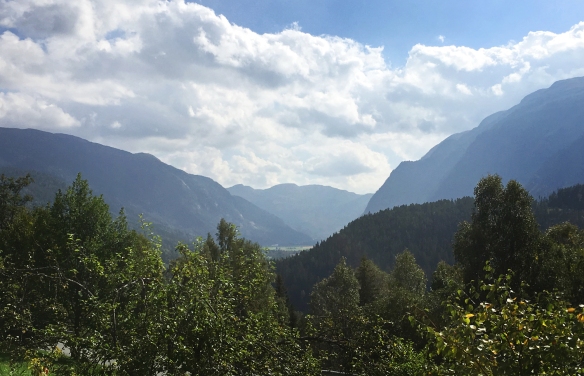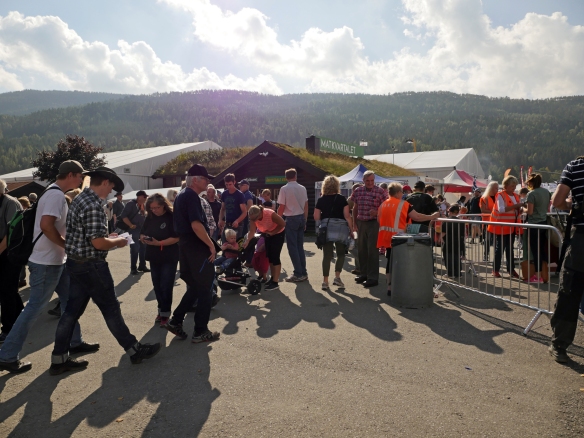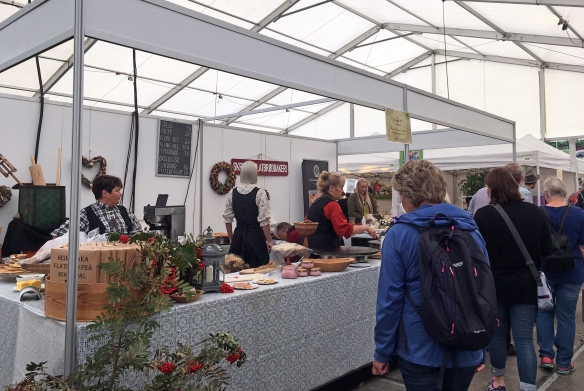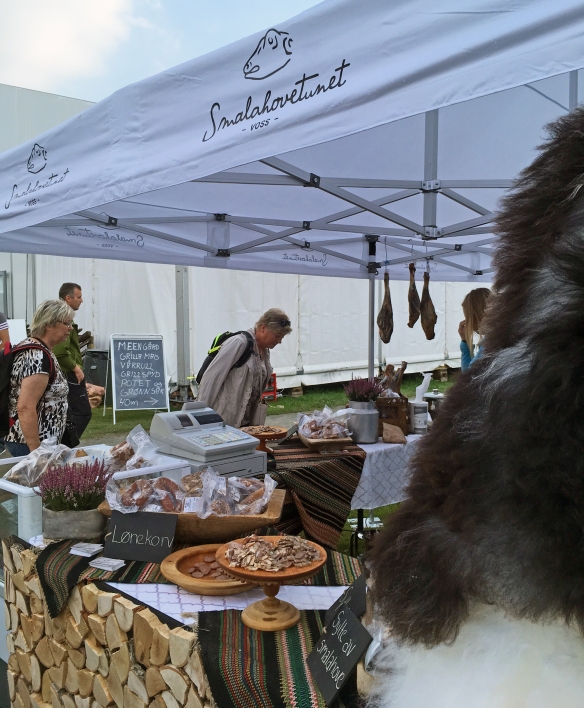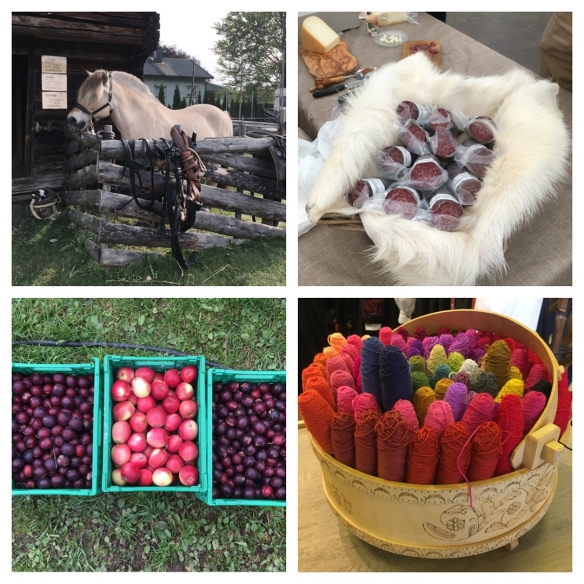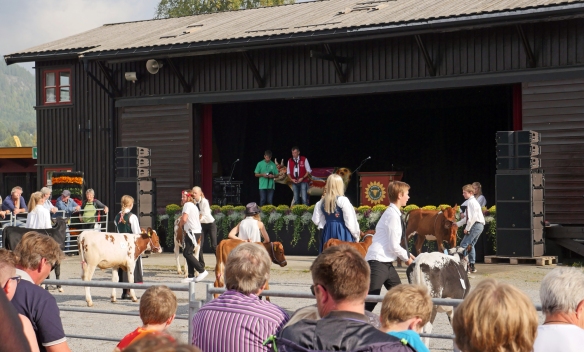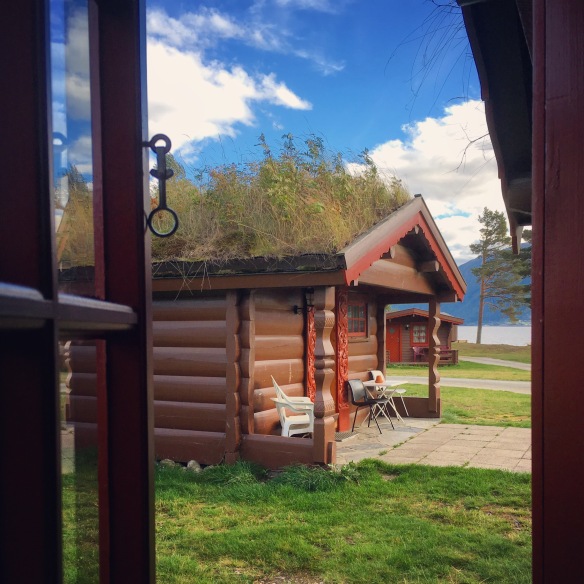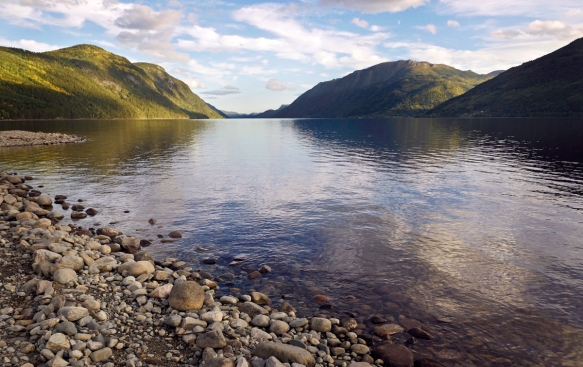This is Norway, country-style. September 9, 2016.
I don’t know what your image of Norway is. Maybe it is chiseled faces and straight hair, sleek neutral-colored clothing, white modern rooms, light wood furniture, angular architecture, tall, elegant mountains and deep blue water as far as the eye can see. Maybe it is red barns, white churches, green forests, trolls and vikings. Maybe it is all that and more.
Indeed, Norway IS all that. And more.
Seljord is a small town deep in inner-Telemark. This is Norwegian farm country and that makes it a special place. Norwegian farmers work in a difficult position: there’s not a lot of agricultural land within the country, the growing season is relatively short and the latitude precludes extensive grain production, among other challenges. The agricultural sector is unionized and receives considerable subsidies from the government. There is some debate about these subsidies (as in most countries), but “Agriculture Minister Trygve Slagsvold Vedum defended Norway’s system. ‘If we want food production in our country, this is the way it has to be,’ he said.”1
The value of agriculture to the Norwegian society is thus summarized by the County Governor of Telemark: “The most important societal role of Norwegian agriculture is to ensure the sufficient provision of a variety of wholesome food. Agriculture is also important in that it helps maintain a decentralised population and employment opportunities throughout Norway, as well as bringing about environmental benefits through the preservation of biodiversity and the Norwegian cultural landscape. Agriculture also makes use of the capacity of the soil and trees for carbon storage. Agriculture is also important for ensuring that traditional knowledge and culture are passed on to new generations.”2
There you have it. Some parts of Norway are all about this kind of traditional knowledge and culture and the process of passing it on to new generations. Since 1866, there has been an agricultural fair in Seljord and it’s called Dyrsku’n. Attendance runs about 80,000 visitors: “2. Fredagen i September samlast over 80 000 menneskje på Dyrskuplassen i Seljord for aktivitetar, handel og moro for både store og små.” This year they celebrated their 150th anniversary, and it was fun! You can read about the fair in English or in Norwegian.
The morning started out foggy, but the weather turned out to be perfect. I arrived at the edge of town about 9:20 and the traffic slowed almost to a stop. It took another 20 minutes until I was parked, but the 60kr/$7.50 parking system was efficient and well-directed, using just about every available field and potential parking area in the town.
It would have been easy to spend several days there- indeed many come with their RV’s and do just that. I walked through the entire place, looking at everything I could, tasting a few unusual things, speaking only Norwegian, and generally doing my paid-ticket-holder’s duty to soak it all up.
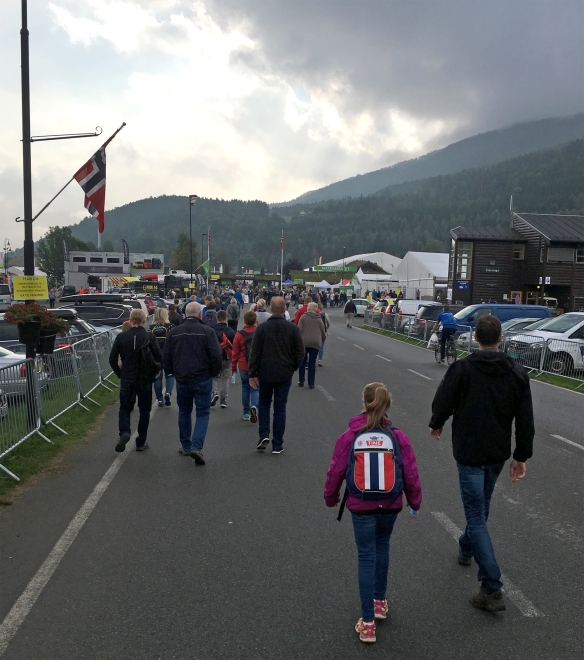
At one of the entrances. The young girl wears a backpack with the logo from the country’s largest dairy producer. They make Jarlsberg, among other things.3
I stopped at several notable locations, the first and foremost being the food hall, where there were handmade farm cheeses, bags of seasoned almonds, gourmet gravlax (salmon), lefse of all sorts, other flatbreads, the widest variety of summer sausages I’ve ever seen, jams, fresh fruit, pastries and breads, and so on and so on. Outside the main food tent were rows and rows of individual food stalls: more summer sausages and cured meats (I tried a small bit of smalahove), raw honey, pølser (cooked fresh sausages), venison burgers, loaded baked potatoes, sandwiches, and one very popular, overworked doughnut stand. (In the US, fair food = deep-fried food. End of story. There is no other food at the fair.)
At Dyrsku’n, there is something for just about everyone: rides, food, late-model tractors and exciting new farm implements, many kinds of handmade goods and crafts such as knives, bunader, silver jewelry and clothing, sheepskins, hardware store tents, tents with factory-made Norwegian sweaters and wool socks (daily-wear; not fancy and not made for tourists but you know I bought a 290kr/$36 sweater and a 180kr/$22 pair of mittens anyway), booths with so many different kinds of extreme-weather reflective outdoor clothing and farm shoes and Helly Hansen gear and lots of motorcycle wear, all kinds of agricultural services, folk music, farm animals, wood stoves, saunas and jetted spas, and even a place to try out some Viking weaponry. It was a feast in every way.
Here are a few very, very brief videos to give you the flavor. (Continued below)
Maybe you get the idea. It was absolutely fascinating. As I spent so many years living in Vermont, my frame of reference is deeply colored by that experience and, of course, all of this looked and sounded and smelled and felt just like Addison County Fair and Field Days. The attendees were more fully and tastefully clothed and the food was far, far better, but so many elements were the same, including roaming packs of teenagers wearing t-shirts from the “future farmers” organization. Again, I felt right at home.
I spent a few minutes watching the goings-on at the 4-H and traditional arts section: linen-making, horse-shoeing and blacksmithing, traditional knife-making, etc. Then I moved on over to the handwork buildings. There were 2 sections: one for youth, who took the traditional crafts in all kinds of new directions, and one for professionals. This is where the Almankås bunad booth was, with East and West Telemark bunads displayed (but not one from Tinn). This building had other things, like lots of knitting, modern jewelry, stained glass, millinery and even a quilter’s booth.

After three hours, my feet felt like lead and every one of my physical senses was completely and totally overwhelmed. I walked back to where I had begun the morning, bought an elgpita (pita bread with soft, marinated, delicious moose meat, a seasoned sauce and chopped salad relish) and a Solo (orange soda), and had to call it a day. I walked back to my car and got in, closed the door, and breathed in the silence. So. Quiet.
It was a lovely afternoon, and I enjoyed the hour and a half drive back toward Tinn. This  time I stopped at a picnic area and got out to explore. There was a small trail that went down toward the steep rocky shore, and I took it half-way down. It was a lovely view of the lake from there. I enjoyed the sounds of the breeze, the fresh September air and the shades of blue all around me. Even down by my feet. I looked again, then closer, and realized what I was looking at: wild blueberries! I was almost certain of it. I decided to use the magic of modern social media to make sure that what I was looking at was indeed edible. I posted a picture to Instagram, waited about 2 minutes, then read a response by my friend in Sweden: yes, wild blueberries.
time I stopped at a picnic area and got out to explore. There was a small trail that went down toward the steep rocky shore, and I took it half-way down. It was a lovely view of the lake from there. I enjoyed the sounds of the breeze, the fresh September air and the shades of blue all around me. Even down by my feet. I looked again, then closer, and realized what I was looking at: wild blueberries! I was almost certain of it. I decided to use the magic of modern social media to make sure that what I was looking at was indeed edible. I posted a picture to Instagram, waited about 2 minutes, then read a response by my friend in Sweden: yes, wild blueberries.
I hadn’t brought anything down from the car in which to collect blueberries, so I gathered as many as one hand could hold (and a few lingonberries) and headed back up the hill to the car. I spent the afternoon hand-washing clothes and hanging them to dry. I opened up both the windows and let the strong breeze blow through as I laid on the couch and wrote in my journal for a long time. Dinner was nearly a repeat of Thursday’s.
When the sun was beginning to head toward the mountains, I went out for a walk along the shore.
Then I took a drive up 755 along the Austbygdåe river. Again, a magical evening. I stopped at a picnic area along the river and took photographs of the waterfall and river in the evening light. They do not do it justice.
When I came home, I cleaned up a bit and made sure I had everything set for the Saturday morning Tinnbunad-makers’ meeting in Atrå.
Another adventure awaited….
1: https://www.thelocal.no/20130920/norway-has-worlds-highest-farm-subsidies
2. https://www.fylkesmannen.no/en/Telemark/Agriculture-and-food/
3. http://www.tine.no/english Also, Norwegians are kind of serious about their dairy. Meet Mr. Melk

